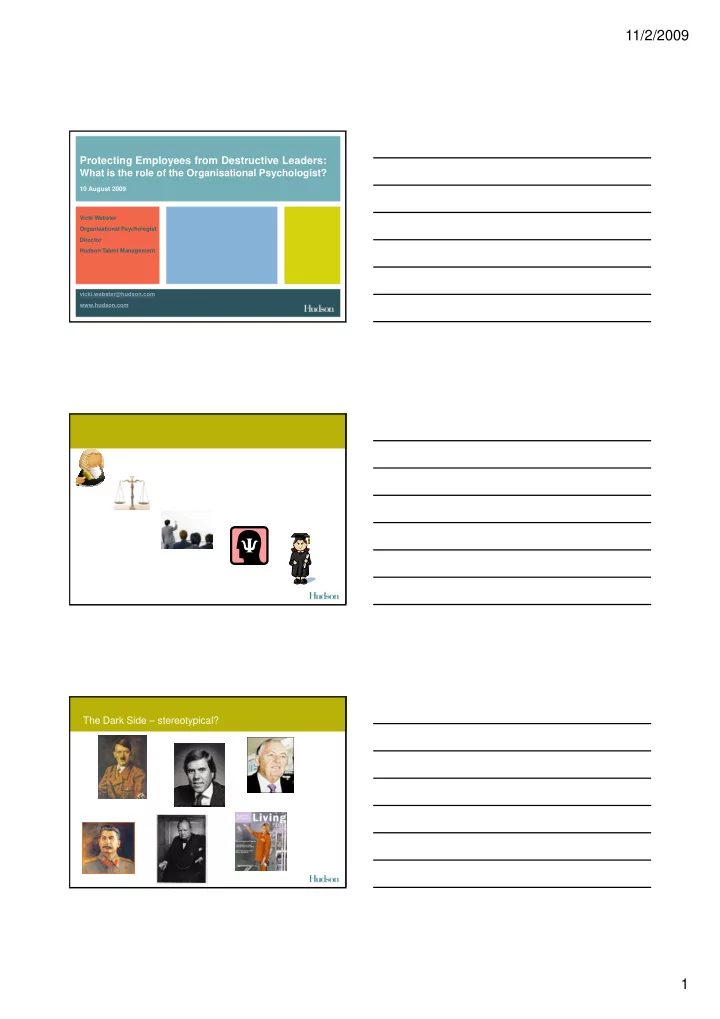

11/2/2009 Protecting Employees from Destructive Leaders: What is the role of the Organisational Psychologist? 10 August 2009 Vicki Webster Organisational Psychologist Director Hudson Talent Management vicki.webster@hudson.com www.hudson.com The Dark Side – stereotypical? 1
11/2/2009 “In spite of all the work on leadership that assumes it by definition to be good… we exercise power, authority and influence in ways that do harm. This harm is not necessarily deliberate. It can be the result of carelessness or neglect. But this does not make it less injurious and, in some cases, calamitous.” – Barbara Kellerman , Bad Leadership, 2004 What characteristics and behaviours have you observed in managers and leaders behaving badly? The Bright Side of Leadership • Transformational leaders, who are: – Charismatic and inspiring – Treating followers as individuals – Showing Integrity - role modelling values – Engendering a strong sense of purpose – Intellectually stimulating followers – Coaching and developing others • Transactional leaders, who: – Achieving results – Acknowledging and rewarding achievement – Managing quality 2
11/2/2009 � � Leadership Derailers 1 Toxic Managers 2 Destructive Leadership 3 (situational strengths) (exhibit some behaviours of personality disorders) Socialised Power Personalised Power Strengths overused: � Compulsive Leader � Narcissists � � � Self confident » Arrogant Narcissistic Leader Machiavellian � Assertive » Intimidating; � Paranoid Leader � Psychopaths argumentative � Codependent Leader � Sociopaths � Achievement drive; Competitive � � » Win at any cost; manipulative Passive-Aggressive Leader Abusive Supervision � � Unethical Leader Rallying individual support for cause or idea » Passive- Aggressive � High standards » Micromanaging Negative traits not addressed: � Low emotional control » moody, volatile 3 Babiak & Hare, 2007; 1 Benson & Campbell, 2007 2 McIntosh & Rima, 1997; Clarke, 2005; Lubit, 2004 Paulhus & Williams, 2002 Leadership derailers or overused strengths? High Performance Low High Strength of preference for using or relying on derailing behaviours Benson & Campbell, 2007 Manager Leadership Derailer Study Archival, deidentified data that had been collected over 20 months: • Profiled using Global Personality Inventory (GPI) proprietary online tool • Leadership Profile for 301 executives and managers (22 executives, 182 managers and 97 frontline leaders) • Profiled for selection or development purposes between January 2007 and August 2008 • Range of industries and occupations, e.g. retail/consumer, financial and insurance services, professional services, manufacturing • 211 from private sector and 90 from public sector – no significant differences between private and public sector leaders • 193 males and 108 females – no significant differences between male and female managers 3
11/2/2009 Leadership Derailer Study - Prevalence In extreme (70% or higher than norm group) these five quasi- leadership tactics, measured using the Global Personality Inventory (GPI), can lose the support of others: • Ego-centred; narcisstic 59 (20%) • Intimidating 86 (28.5%) • Manipulating 87(29%) • Micromanaging 83 (27.5%) • Passive Aggressive; avoidant of conflict 59 (20%) Leadership Derailer Study - Prevalence 186 participants (62%) of the whole sample reported at least one strong to extreme preference to use a derailing behaviour: • Extreme levels of all five potential derailers 8 • Extreme levels of four potential derailers 12 • Extreme levels of three potential derailers 35 • Extreme levels of two potential derailers 49 • Extreme levels of one potential derailer 82 Leadership Derailer Study - Motivation Spreier, Fontaine and Malloy (2006) model of motivation: – Achievement – there was a significant relationship between a high level of achievement drive and a preference to use ego centred behaviours. There was no significant relationship to any other derailer. – Affiliation – high levels of sociability were negatively correlated to a preference to micromanage others. There was no significant relationship to any other derailer. – Personalised Power – high levels of independence and competitiveness were significantly correlated to strong preferences to use all derailers – Socialised Power – high levels of interdependence (the will to achieve through others) was significantly negatively correlated to the use of all derailers 4
11/2/2009 Theoretical Perspectives Predisposition to use destructive behaviours (personality characteristics) Motivation to use destructive behaviours Opportunity to use destructive behaviours Identifying Destructive Leaders – Indicators How can typical indicators be measured? • Manipulative • Pathological lying/deceitful • Unempathetic; shallow emotions • Intimidating • Superficial • Egocentric/narcisstic • Unpredictable • Undependable • Unethical • Intolerant • Seeks power • Creates conflict between organisational members Source: Working with Monsters, John Clarke Identifying Destructive Leaders – Diagnostic tools Weaknesses of using self report measures Issue with tools based on DSM-IV personality disorder framework Predicted patterns of responses to bad leadership by followers Challenges of designing 360 degree feedback component: • Observable behaviours vs attributes • Recognising bad leadership behaviours • Rater responses 5
11/2/2009 Preventative Follower Intervention Employee education on how to recognise and deal with harmful behaviours: • Diagnosing follower responses to destructive leadership (role of interpretation) • Recognising destructive leadership (incompetent vs unethical) – how? • Dealing with destructive leadership • Developing Personal Resilience (Martin Seligman) • Developing Career Resilience • What are the challenges for designing this intervention? • What are the key components that need to be included? Critical Incident Follower Intervention Workplace conferencing (based on restorative justice principles): • Interview all stakeholders involved in incident • Organise conference between executive, affected employees and support group • Facilitation techniques – What happened? – How have people been affected? – How can we improve the situation? – What would you like to see happen after this conference? • Agree actions – Does that seem fair? – Could we do that? • Summarise the agreement • Follow up implementation of the agreement • What are the challenges for designing this intervention? • What are the challenges for implementing this intervention? "I am reminded how hollow the label of leadership sometimes is and how heroic followership can be." — Warren Bennis 6
11/2/2009 Discussion Time – Questions or Comments? 7
Recommend
More recommend